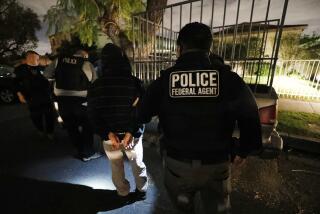Surveillance Teams to Help Fight Graffiti
- Share via
They’ve tried to rub it out. They’ve tried to paint it out. Now Los Angeles city officials will try to snoop it out.
In the latest effort to slow down a spray paint scourge that has not been tamed by nearly a dozen other city programs, graffiti and graffiti vandals will be targeted by special surveillance teams under a proposal approved Tuesday by the Los Angeles City Council.
The surveillance program will team reserve police officers and neighborhood volunteers to watch over some of the city’s most blighted walls, signs and bridges. It will be tested in three of 18 police divisions--Hollenbeck, Southeast and Pacific--and implemented citywide if it succeeds.
“People need to know that if they are going to try to destroy someone’s property that someone is watching and they will go to jail,” said Cmdr. Maurice Moore, who coordinates anti-graffiti programs for the Los Angeles Police Department.
The scope of the effort, though, remains unclear.
Both reserve police officers and civilians are being asked to volunteer for the special surveillance teams, which the Police Department has only begun to recruit. However, reserve officers will not be pulled off other duties to make up the graffiti details, so the program will depend on the willingness of reserves to work more hours.
But Moore and City Councilwoman Joan Milke Flores, who conceived of the surveillance teams, said they are confident that both police reserves and the public are ready to serve.
“Graffiti will become a higher priority,” said Flores, who is running for reelection.
She added that, because reserve officers are volunteers, the surveillance will not cost the taxpayers extra money.
“It’s a cost savings and it’s a city savings,” Flores said. “If we don’t do something soon, we will lose our city to graffiti.”
Under the program, the citizen sleuths will be armed with radios and will hide in positions where they can watch structures that are frequent graffiti targets.
From cars, rooftops, homes and businesses, the volunteers will radio to reserve officers, who will move in to arrest graffiti taggers. If the Police Department can find the funds, it might also buy video cameras to try to catch the spray paint taggers on tape. Also under consideration is a proposal to allow volunteers to bring their own video equipment.
The object of the program is to eliminate one of the biggest barriers to successful graffiti prosecutions--a lack of witnesses. “It’s much better to make the arrest right then,” said Moore, “rather than try to follow up later based on someone’s gang moniker.”
The volunteers will be rigorously trained to ensure that they are not placed in danger and that they do not try to stop criminals, officials said. Reserve officers who will make the arrests are themselves volunteers, but they carry guns and wear uniforms nearly identical to those of regular LAPD officers.
The surveillance teams approved by the council Tuesday would be similar to ones that have been keeping watch in the police department’s Harbor Division since last fall. There, as many as 40 volunteers, equipped with two-way radios, spend some of their Friday and Saturday nights peering into the darkness trying to spot paint vandals in mid-spray.
Nearby, a patrol car waits, ready to swoop into action to arrest the taggers.
Citizen surveillance teams also have been deployed specifically to watch crimes--including graffiti tagging--in the Devonshire, Foothill, West Valley and Northeast divisions of the Police Department.
In another effort to get citizens involved in cracking down on taggers, citizens and reserve officers are being trained in the San Fernando Valley to recognize distinctive tags and to take photographs and complete police reports documenting the damage. The information is being used to catalogue graffiti to make it easier to prosecute prolific vandals, even if they are not seen doing the damage.
The graffiti teams are expected to begin their stakeouts in about a month and a half.
As part of its anti-graffiti push, the City Council also voted Tuesday to create a toll-free telephone number for those who want to report graffiti. And the council voted to placed one anti-graffiti organization, Operation Clean Sweep, in charge of coordinating continuing efforts by nearly a dozen other city bureaus and departments.
Times staff writer Richard Lee Colvin contributed to this story.
More to Read
Sign up for Essential California
The most important California stories and recommendations in your inbox every morning.
You may occasionally receive promotional content from the Los Angeles Times.











